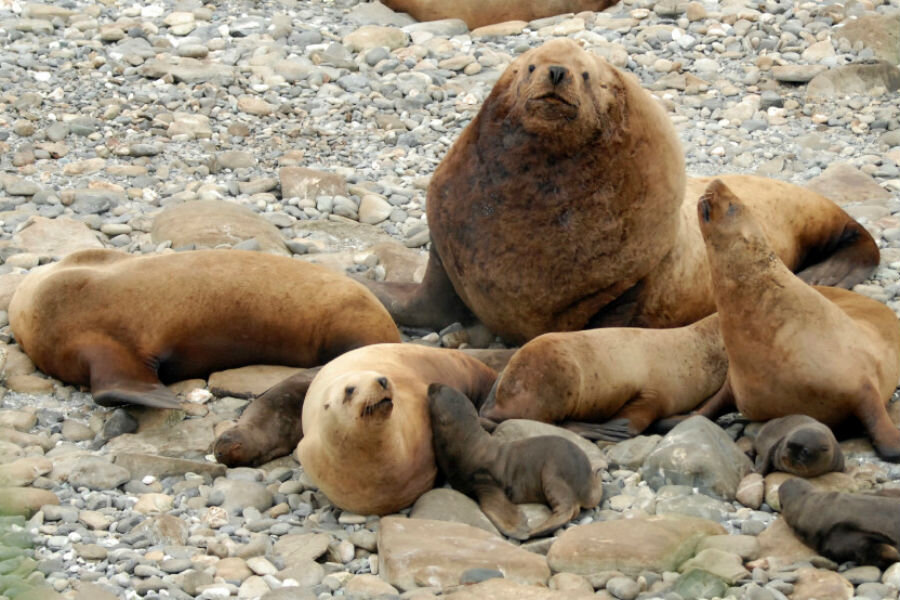Can crowdsourcing help save the Steller sea lions?
Loading...
The western Aleutian islands, an isolated part of Alaska, used to be dominated by sea lions. But lately, they’ve become more difficult to spot – and scientists are turning to the public to help figure out why.
On Wednesday, researchers from NOAA's Alaska Fisheries Science Center, which has been tracking local sea lion populations, launched its latest project, known as Steller Watch. The project, hosted on crowdsourcing platform Zooniverse, trains volunteers to sort through hundreds of thousands of photos taken by research cameras and tag the pictures with sea lions. Researchers then review the most relevant photos, including those with sea lions that have been branded for tracking purposes.
The goal: Harness the power of the crowd to sort through the reams of data and find out why Steller sea lion populations in the area continue to decline. For volunteers, it may also be a way to develop a tangible connection to conservation efforts.
“I hope the public wants to get involved. We’re all scientists,” project leader Katie Sweeney, who primarily studies Steller sea lions, said in a NOAA news release. “We all live in the world and observe things.”
Steller sea lions are the largest members of the eared seal family. According to the Alaska Department of Fish and Game, adult males – who weigh almost 1200 lbs – can be almost 11 feet long, while fully-grown females, who average 580 lbs, are almost 9 feet long.
Across most of Alaska, sea lion populations have been rebounding. In the western Aleutian islands, however, scientists have observed a 94 percent drop over the past 30 years, and they don't know why. The islands’ remote location means scientists make only one or two journeys there per year, impeding long-term observation of the Stellers.
To improve the consistency of data collection, the research team installed 20 cameras in 6 locations in 2012. Each camera is set to take a photo every 5 to 20 minutes, giving researchers a window onto the sea lions’ daily lives.
The scientists have also branded a few hundred sea lions, and the cameras help them monitor these animals’ survival rate. Already, the data has revealed that survival rates for pups and young juveniles in the western Aleutian islands are similar to other areas.
“Every time we see juveniles they look healthy. So, it wasn’t a total surprise. But it was interesting to see the survival data back that up,” Ms. Sweeney said.
But with so many photos to sort through to draw these kind of conclusions – the cameras produced nearly 380,000 images in 2016 alone – the handful of NOAA volunteers became overwhelmed.
“Getting the data in a timely manner is so important," she explained. "If we get the images but can’t review them for years, we would not have relevant information to inform management decisions."
That dilemma prompted researchers to take an unusual approach to photo classification: crowdsourcing.
In recent years, researchers have mobilized citizens for a range of crowdsourcing projects. Whale FM, a program launched by Scientific American, asked ordinary people to help decipher whale conversations. In September, SpaceX founder Elon Musk reached out over Twitter to ask for the public’s help in investigating the explosion of its AMOS-6 mission.
On platforms like Zooniverse, which is hosting Steller Watch, volunteers can sign up for many efforts that require little more than a computer and an Internet connection. Recent examples include exploring Mars, teaching computers to recognize different animal faces, and transcribing documents by Shakespeare’s contemporaries.
Steller Watch, which asks citizen scientists to sort sea lion photos, resembles the Snapshot Serengeti campaign, where researchers hid cameras across the Serengeti in hopes of understanding how animals within the ecosystem interact. With 1.2 million photos to sort through, University of Minnesota doctoral candidate Alexandra Swanson turned to Zooniverse, where volunteers classified 18 months of photos in 10 days.
Steller Watch is experiencing similar success. By Saturday afternoon, over 2,500 volunteers had already classified more than 330,000 pictures, or just over a quarter of the total.
By sifting out the pictures with branded sea lions, the volunteers are helping researchers target their search and lead them to the answers they need.
“Ultimately, we are most interested in finding marked Steller sea lions,” Sweeney wrote on the campaign website. "Knowing when and where these sea lions are born and seeing them throughout their lifetime will allow us to estimate important information about the population, such as movement patterns and life history rates like survival and natality."








